Research Project on Twin-to-Twin Transfusion Syndrome (TTTS)
VerifiedAdded on 2024/05/15
|35
|11345
|159
Project
AI Summary
This research project investigates the effects of Twin-to-Twin Transfusion Syndrome (TTTS) on pregnant women and their babies, both during and after delivery. It explores the causes of TTTS, its impact on maternal and fetal health, and the role of health and social care in preventing and managing the syndrome. The research employs a theoretical approach, drawing data from books, articles, journals, and hospital surveys to understand the complexities of TTTS and its associated risks, including miscarriage, premature birth, and potential long-term neurological issues in infants. The study aims to provide insights into improving healthcare practices and reducing the negative impacts of TTTS on affected families.
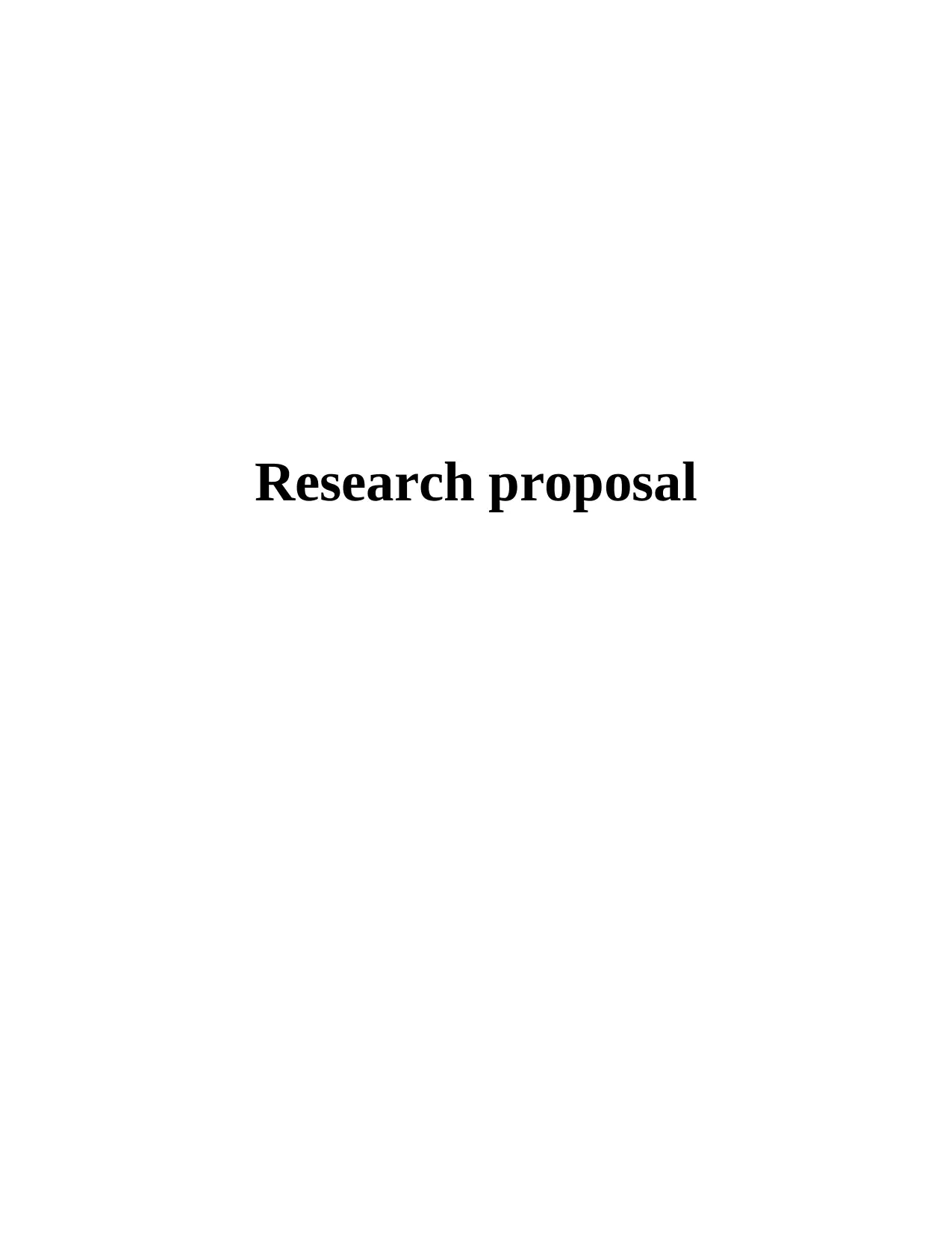
Research proposal
Paraphrase This Document
Need a fresh take? Get an instant paraphrase of this document with our AI Paraphraser
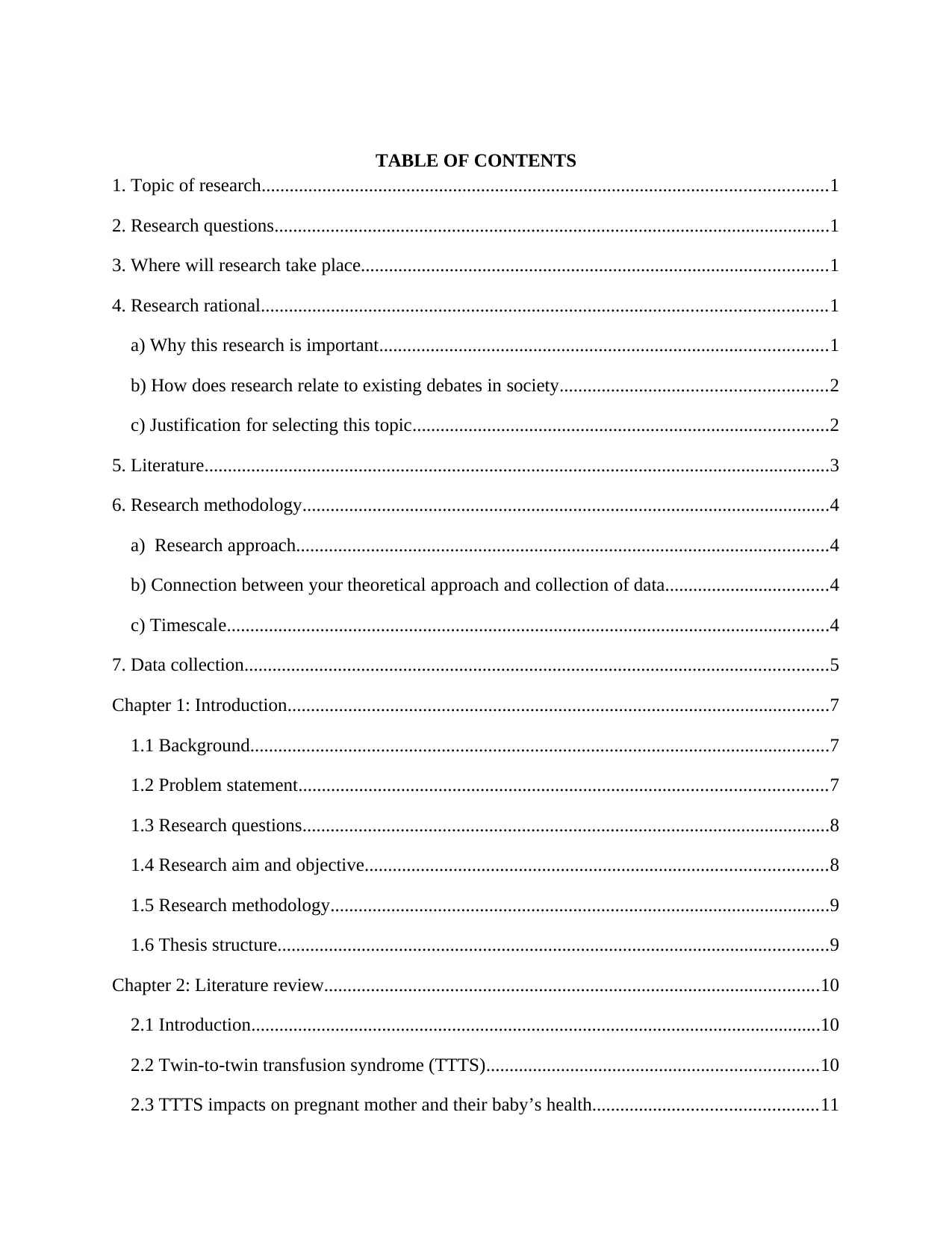
TABLE OF CONTENTS
1. Topic of research.........................................................................................................................1
2. Research questions.......................................................................................................................1
3. Where will research take place....................................................................................................1
4. Research rational.........................................................................................................................1
a) Why this research is important................................................................................................1
b) How does research relate to existing debates in society.........................................................2
c) Justification for selecting this topic.........................................................................................2
5. Literature......................................................................................................................................3
6. Research methodology.................................................................................................................4
a) Research approach..................................................................................................................4
b) Connection between your theoretical approach and collection of data...................................4
c) Timescale.................................................................................................................................4
7. Data collection.............................................................................................................................5
Chapter 1: Introduction....................................................................................................................7
1.1 Background............................................................................................................................7
1.2 Problem statement.................................................................................................................7
1.3 Research questions.................................................................................................................8
1.4 Research aim and objective...................................................................................................8
1.5 Research methodology...........................................................................................................9
1.6 Thesis structure......................................................................................................................9
Chapter 2: Literature review..........................................................................................................10
2.1 Introduction..........................................................................................................................10
2.2 Twin-to-twin transfusion syndrome (TTTS).......................................................................10
2.3 TTTS impacts on pregnant mother and their baby’s health................................................11
1. Topic of research.........................................................................................................................1
2. Research questions.......................................................................................................................1
3. Where will research take place....................................................................................................1
4. Research rational.........................................................................................................................1
a) Why this research is important................................................................................................1
b) How does research relate to existing debates in society.........................................................2
c) Justification for selecting this topic.........................................................................................2
5. Literature......................................................................................................................................3
6. Research methodology.................................................................................................................4
a) Research approach..................................................................................................................4
b) Connection between your theoretical approach and collection of data...................................4
c) Timescale.................................................................................................................................4
7. Data collection.............................................................................................................................5
Chapter 1: Introduction....................................................................................................................7
1.1 Background............................................................................................................................7
1.2 Problem statement.................................................................................................................7
1.3 Research questions.................................................................................................................8
1.4 Research aim and objective...................................................................................................8
1.5 Research methodology...........................................................................................................9
1.6 Thesis structure......................................................................................................................9
Chapter 2: Literature review..........................................................................................................10
2.1 Introduction..........................................................................................................................10
2.2 Twin-to-twin transfusion syndrome (TTTS).......................................................................10
2.3 TTTS impacts on pregnant mother and their baby’s health................................................11
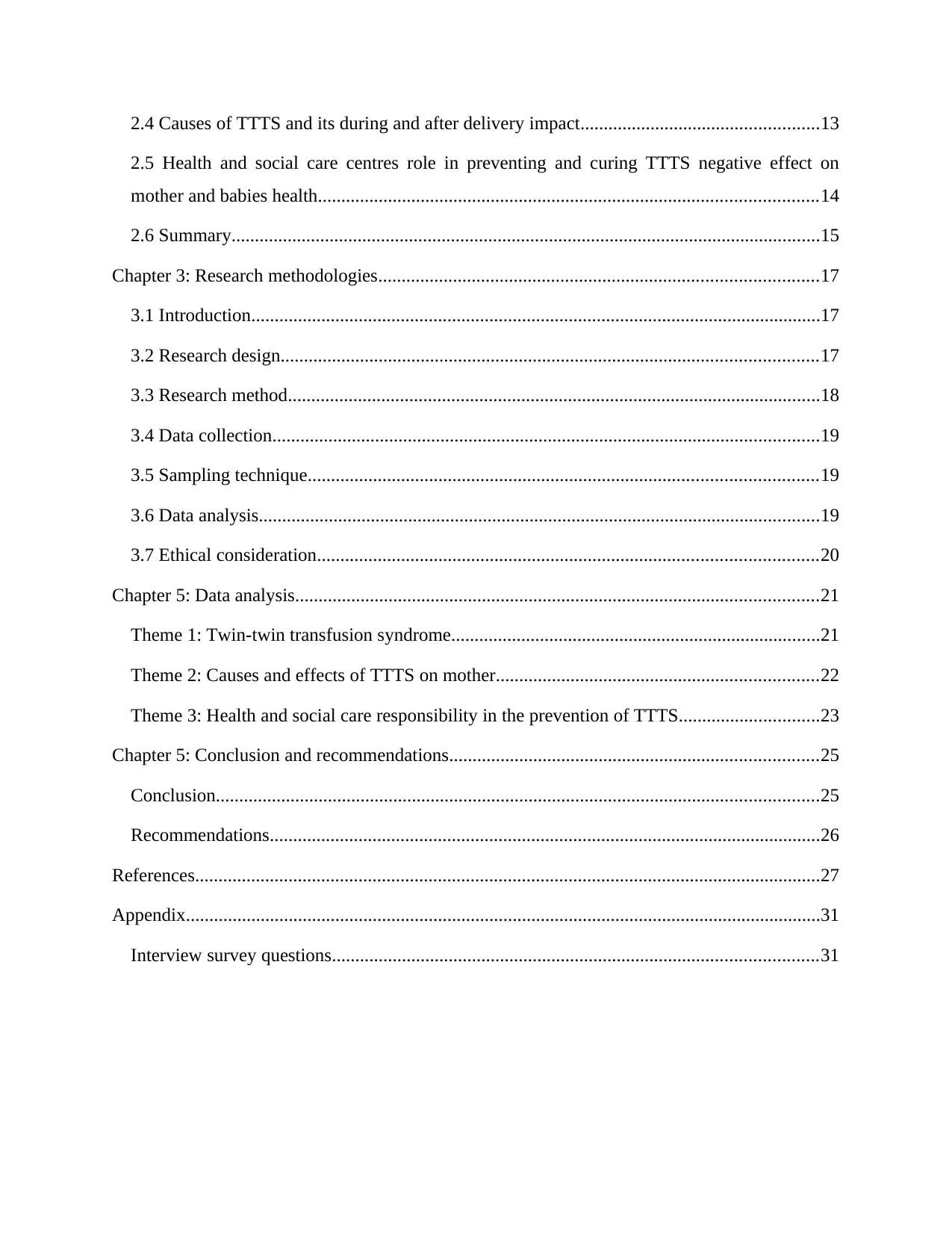
2.4 Causes of TTTS and its during and after delivery impact...................................................13
2.5 Health and social care centres role in preventing and curing TTTS negative effect on
mother and babies health...........................................................................................................14
2.6 Summary..............................................................................................................................15
Chapter 3: Research methodologies..............................................................................................17
3.1 Introduction..........................................................................................................................17
3.2 Research design...................................................................................................................17
3.3 Research method..................................................................................................................18
3.4 Data collection.....................................................................................................................19
3.5 Sampling technique.............................................................................................................19
3.6 Data analysis........................................................................................................................19
3.7 Ethical consideration...........................................................................................................20
Chapter 5: Data analysis................................................................................................................21
Theme 1: Twin-twin transfusion syndrome...............................................................................21
Theme 2: Causes and effects of TTTS on mother.....................................................................22
Theme 3: Health and social care responsibility in the prevention of TTTS..............................23
Chapter 5: Conclusion and recommendations...............................................................................25
Conclusion.................................................................................................................................25
Recommendations......................................................................................................................26
References......................................................................................................................................27
Appendix........................................................................................................................................31
Interview survey questions........................................................................................................31
2.5 Health and social care centres role in preventing and curing TTTS negative effect on
mother and babies health...........................................................................................................14
2.6 Summary..............................................................................................................................15
Chapter 3: Research methodologies..............................................................................................17
3.1 Introduction..........................................................................................................................17
3.2 Research design...................................................................................................................17
3.3 Research method..................................................................................................................18
3.4 Data collection.....................................................................................................................19
3.5 Sampling technique.............................................................................................................19
3.6 Data analysis........................................................................................................................19
3.7 Ethical consideration...........................................................................................................20
Chapter 5: Data analysis................................................................................................................21
Theme 1: Twin-twin transfusion syndrome...............................................................................21
Theme 2: Causes and effects of TTTS on mother.....................................................................22
Theme 3: Health and social care responsibility in the prevention of TTTS..............................23
Chapter 5: Conclusion and recommendations...............................................................................25
Conclusion.................................................................................................................................25
Recommendations......................................................................................................................26
References......................................................................................................................................27
Appendix........................................................................................................................................31
Interview survey questions........................................................................................................31
⊘ This is a preview!⊘
Do you want full access?
Subscribe today to unlock all pages.

Trusted by 1+ million students worldwide
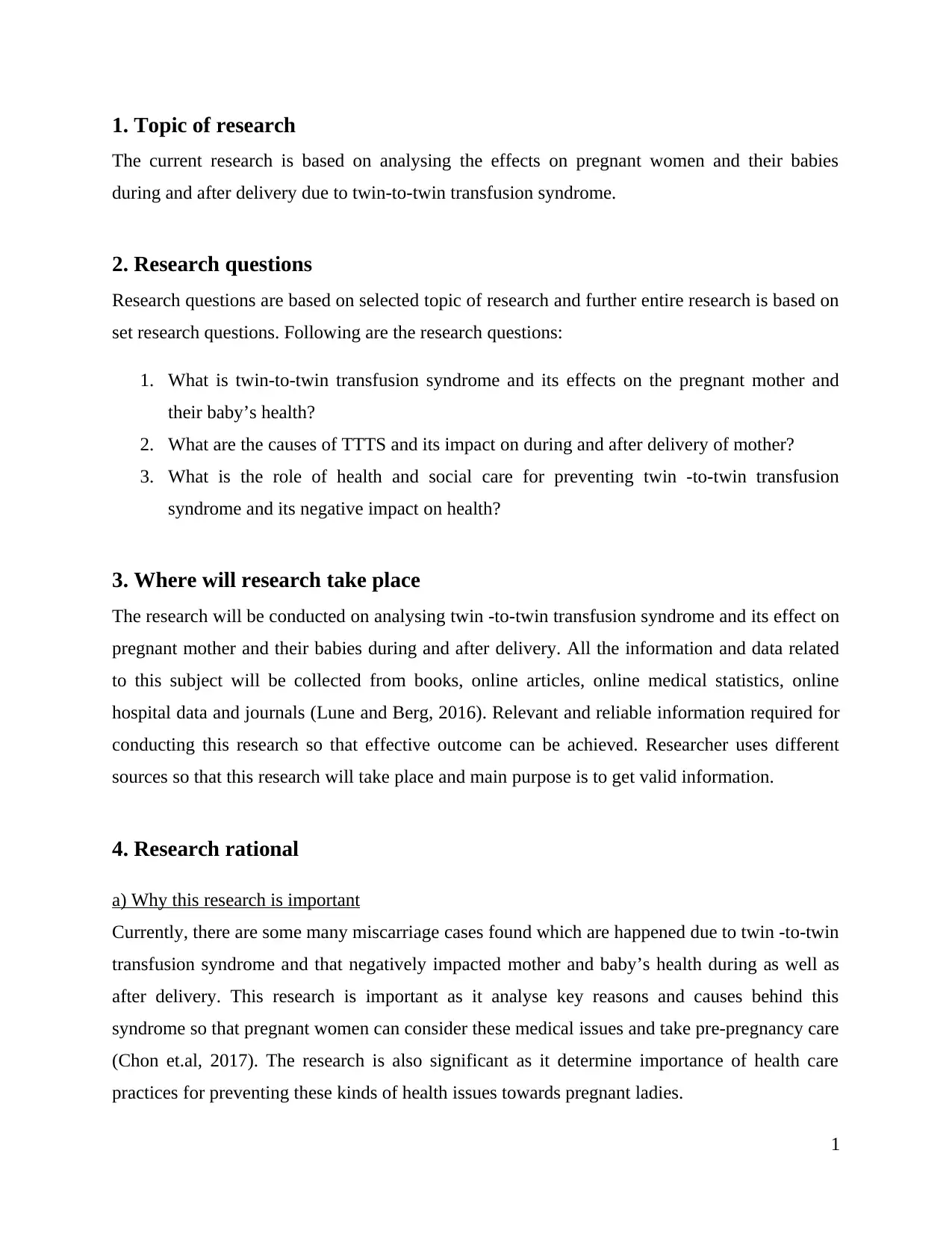
1. Topic of research
The current research is based on analysing the effects on pregnant women and their babies
during and after delivery due to twin-to-twin transfusion syndrome.
2. Research questions
Research questions are based on selected topic of research and further entire research is based on
set research questions. Following are the research questions:
1. What is twin-to-twin transfusion syndrome and its effects on the pregnant mother and
their baby’s health?
2. What are the causes of TTTS and its impact on during and after delivery of mother?
3. What is the role of health and social care for preventing twin -to-twin transfusion
syndrome and its negative impact on health?
3. Where will research take place
The research will be conducted on analysing twin -to-twin transfusion syndrome and its effect on
pregnant mother and their babies during and after delivery. All the information and data related
to this subject will be collected from books, online articles, online medical statistics, online
hospital data and journals (Lune and Berg, 2016). Relevant and reliable information required for
conducting this research so that effective outcome can be achieved. Researcher uses different
sources so that this research will take place and main purpose is to get valid information.
4. Research rational
a) Why this research is important
Currently, there are some many miscarriage cases found which are happened due to twin -to-twin
transfusion syndrome and that negatively impacted mother and baby’s health during as well as
after delivery. This research is important as it analyse key reasons and causes behind this
syndrome so that pregnant women can consider these medical issues and take pre-pregnancy care
(Chon et.al, 2017). The research is also significant as it determine importance of health care
practices for preventing these kinds of health issues towards pregnant ladies.
1
The current research is based on analysing the effects on pregnant women and their babies
during and after delivery due to twin-to-twin transfusion syndrome.
2. Research questions
Research questions are based on selected topic of research and further entire research is based on
set research questions. Following are the research questions:
1. What is twin-to-twin transfusion syndrome and its effects on the pregnant mother and
their baby’s health?
2. What are the causes of TTTS and its impact on during and after delivery of mother?
3. What is the role of health and social care for preventing twin -to-twin transfusion
syndrome and its negative impact on health?
3. Where will research take place
The research will be conducted on analysing twin -to-twin transfusion syndrome and its effect on
pregnant mother and their babies during and after delivery. All the information and data related
to this subject will be collected from books, online articles, online medical statistics, online
hospital data and journals (Lune and Berg, 2016). Relevant and reliable information required for
conducting this research so that effective outcome can be achieved. Researcher uses different
sources so that this research will take place and main purpose is to get valid information.
4. Research rational
a) Why this research is important
Currently, there are some many miscarriage cases found which are happened due to twin -to-twin
transfusion syndrome and that negatively impacted mother and baby’s health during as well as
after delivery. This research is important as it analyse key reasons and causes behind this
syndrome so that pregnant women can consider these medical issues and take pre-pregnancy care
(Chon et.al, 2017). The research is also significant as it determine importance of health care
practices for preventing these kinds of health issues towards pregnant ladies.
1
Paraphrase This Document
Need a fresh take? Get an instant paraphrase of this document with our AI Paraphraser
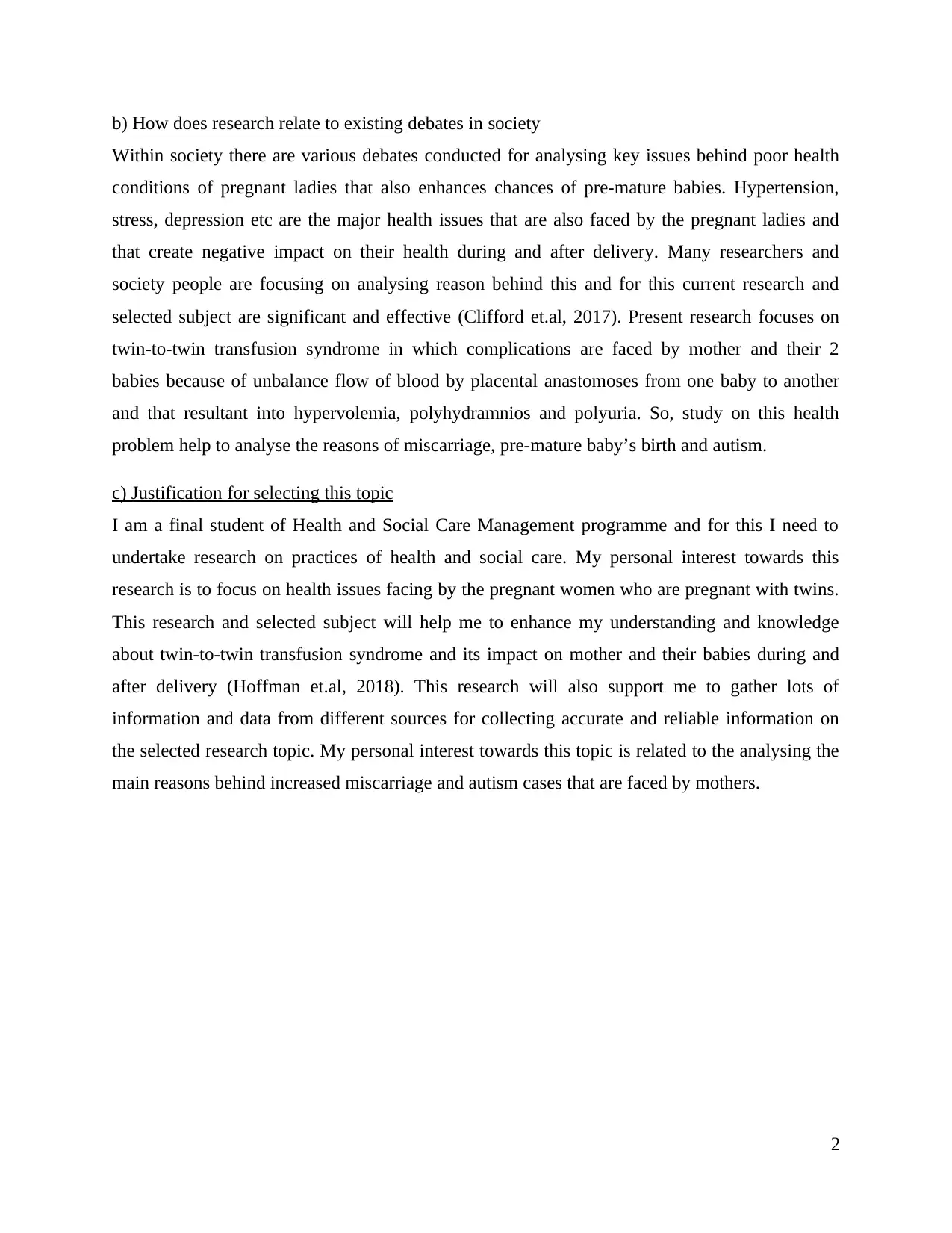
b) How does research relate to existing debates in society
Within society there are various debates conducted for analysing key issues behind poor health
conditions of pregnant ladies that also enhances chances of pre-mature babies. Hypertension,
stress, depression etc are the major health issues that are also faced by the pregnant ladies and
that create negative impact on their health during and after delivery. Many researchers and
society people are focusing on analysing reason behind this and for this current research and
selected subject are significant and effective (Clifford et.al, 2017). Present research focuses on
twin-to-twin transfusion syndrome in which complications are faced by mother and their 2
babies because of unbalance flow of blood by placental anastomoses from one baby to another
and that resultant into hypervolemia, polyhydramnios and polyuria. So, study on this health
problem help to analyse the reasons of miscarriage, pre-mature baby’s birth and autism.
c) Justification for selecting this topic
I am a final student of Health and Social Care Management programme and for this I need to
undertake research on practices of health and social care. My personal interest towards this
research is to focus on health issues facing by the pregnant women who are pregnant with twins.
This research and selected subject will help me to enhance my understanding and knowledge
about twin-to-twin transfusion syndrome and its impact on mother and their babies during and
after delivery (Hoffman et.al, 2018). This research will also support me to gather lots of
information and data from different sources for collecting accurate and reliable information on
the selected research topic. My personal interest towards this topic is related to the analysing the
main reasons behind increased miscarriage and autism cases that are faced by mothers.
2
Within society there are various debates conducted for analysing key issues behind poor health
conditions of pregnant ladies that also enhances chances of pre-mature babies. Hypertension,
stress, depression etc are the major health issues that are also faced by the pregnant ladies and
that create negative impact on their health during and after delivery. Many researchers and
society people are focusing on analysing reason behind this and for this current research and
selected subject are significant and effective (Clifford et.al, 2017). Present research focuses on
twin-to-twin transfusion syndrome in which complications are faced by mother and their 2
babies because of unbalance flow of blood by placental anastomoses from one baby to another
and that resultant into hypervolemia, polyhydramnios and polyuria. So, study on this health
problem help to analyse the reasons of miscarriage, pre-mature baby’s birth and autism.
c) Justification for selecting this topic
I am a final student of Health and Social Care Management programme and for this I need to
undertake research on practices of health and social care. My personal interest towards this
research is to focus on health issues facing by the pregnant women who are pregnant with twins.
This research and selected subject will help me to enhance my understanding and knowledge
about twin-to-twin transfusion syndrome and its impact on mother and their babies during and
after delivery (Hoffman et.al, 2018). This research will also support me to gather lots of
information and data from different sources for collecting accurate and reliable information on
the selected research topic. My personal interest towards this topic is related to the analysing the
main reasons behind increased miscarriage and autism cases that are faced by mothers.
2
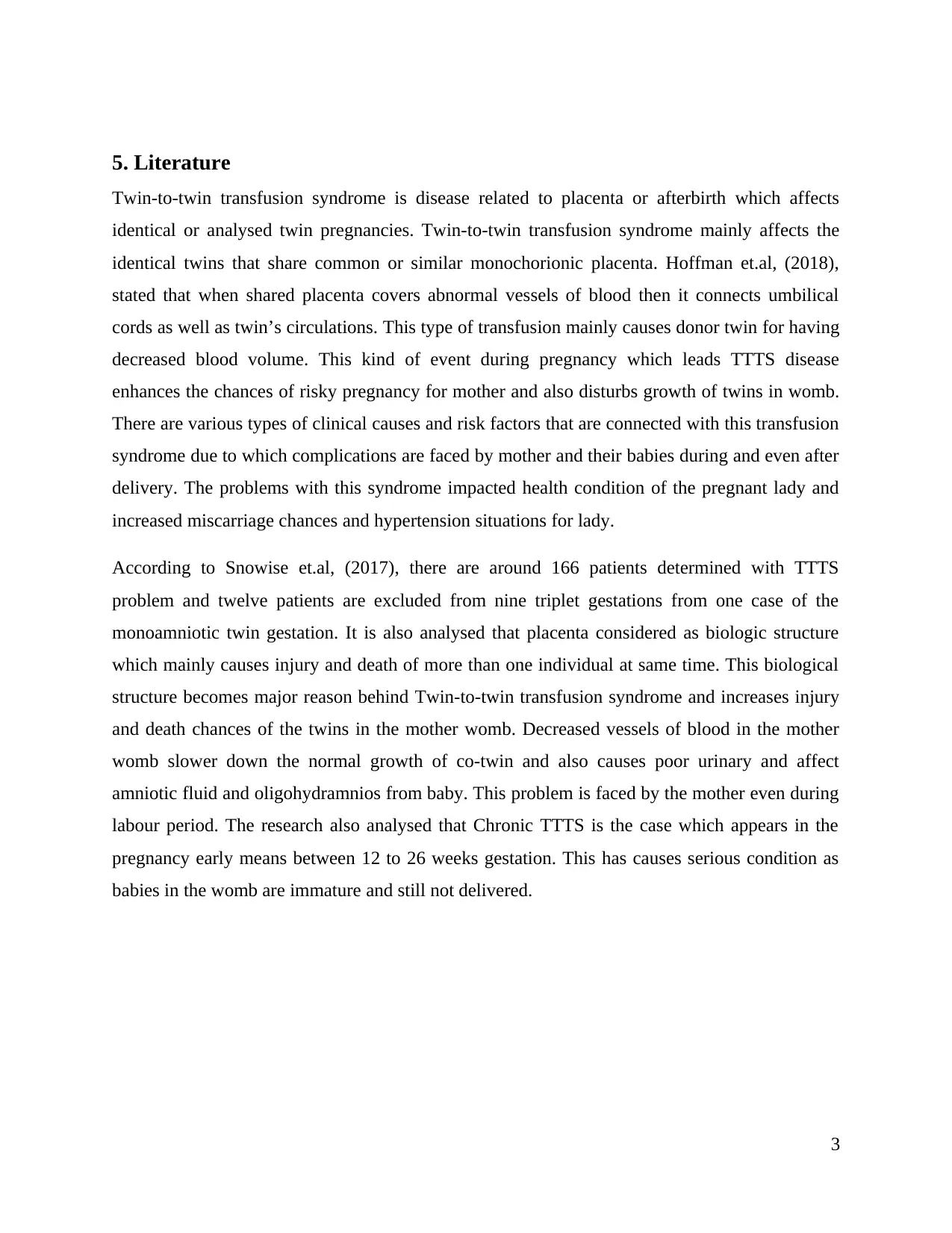
5. Literature
Twin-to-twin transfusion syndrome is disease related to placenta or afterbirth which affects
identical or analysed twin pregnancies. Twin-to-twin transfusion syndrome mainly affects the
identical twins that share common or similar monochorionic placenta. Hoffman et.al, (2018),
stated that when shared placenta covers abnormal vessels of blood then it connects umbilical
cords as well as twin’s circulations. This type of transfusion mainly causes donor twin for having
decreased blood volume. This kind of event during pregnancy which leads TTTS disease
enhances the chances of risky pregnancy for mother and also disturbs growth of twins in womb.
There are various types of clinical causes and risk factors that are connected with this transfusion
syndrome due to which complications are faced by mother and their babies during and even after
delivery. The problems with this syndrome impacted health condition of the pregnant lady and
increased miscarriage chances and hypertension situations for lady.
According to Snowise et.al, (2017), there are around 166 patients determined with TTTS
problem and twelve patients are excluded from nine triplet gestations from one case of the
monoamniotic twin gestation. It is also analysed that placenta considered as biologic structure
which mainly causes injury and death of more than one individual at same time. This biological
structure becomes major reason behind Twin-to-twin transfusion syndrome and increases injury
and death chances of the twins in the mother womb. Decreased vessels of blood in the mother
womb slower down the normal growth of co-twin and also causes poor urinary and affect
amniotic fluid and oligohydramnios from baby. This problem is faced by the mother even during
labour period. The research also analysed that Chronic TTTS is the case which appears in the
pregnancy early means between 12 to 26 weeks gestation. This has causes serious condition as
babies in the womb are immature and still not delivered.
3
Twin-to-twin transfusion syndrome is disease related to placenta or afterbirth which affects
identical or analysed twin pregnancies. Twin-to-twin transfusion syndrome mainly affects the
identical twins that share common or similar monochorionic placenta. Hoffman et.al, (2018),
stated that when shared placenta covers abnormal vessels of blood then it connects umbilical
cords as well as twin’s circulations. This type of transfusion mainly causes donor twin for having
decreased blood volume. This kind of event during pregnancy which leads TTTS disease
enhances the chances of risky pregnancy for mother and also disturbs growth of twins in womb.
There are various types of clinical causes and risk factors that are connected with this transfusion
syndrome due to which complications are faced by mother and their babies during and even after
delivery. The problems with this syndrome impacted health condition of the pregnant lady and
increased miscarriage chances and hypertension situations for lady.
According to Snowise et.al, (2017), there are around 166 patients determined with TTTS
problem and twelve patients are excluded from nine triplet gestations from one case of the
monoamniotic twin gestation. It is also analysed that placenta considered as biologic structure
which mainly causes injury and death of more than one individual at same time. This biological
structure becomes major reason behind Twin-to-twin transfusion syndrome and increases injury
and death chances of the twins in the mother womb. Decreased vessels of blood in the mother
womb slower down the normal growth of co-twin and also causes poor urinary and affect
amniotic fluid and oligohydramnios from baby. This problem is faced by the mother even during
labour period. The research also analysed that Chronic TTTS is the case which appears in the
pregnancy early means between 12 to 26 weeks gestation. This has causes serious condition as
babies in the womb are immature and still not delivered.
3
⊘ This is a preview!⊘
Do you want full access?
Subscribe today to unlock all pages.

Trusted by 1+ million students worldwide
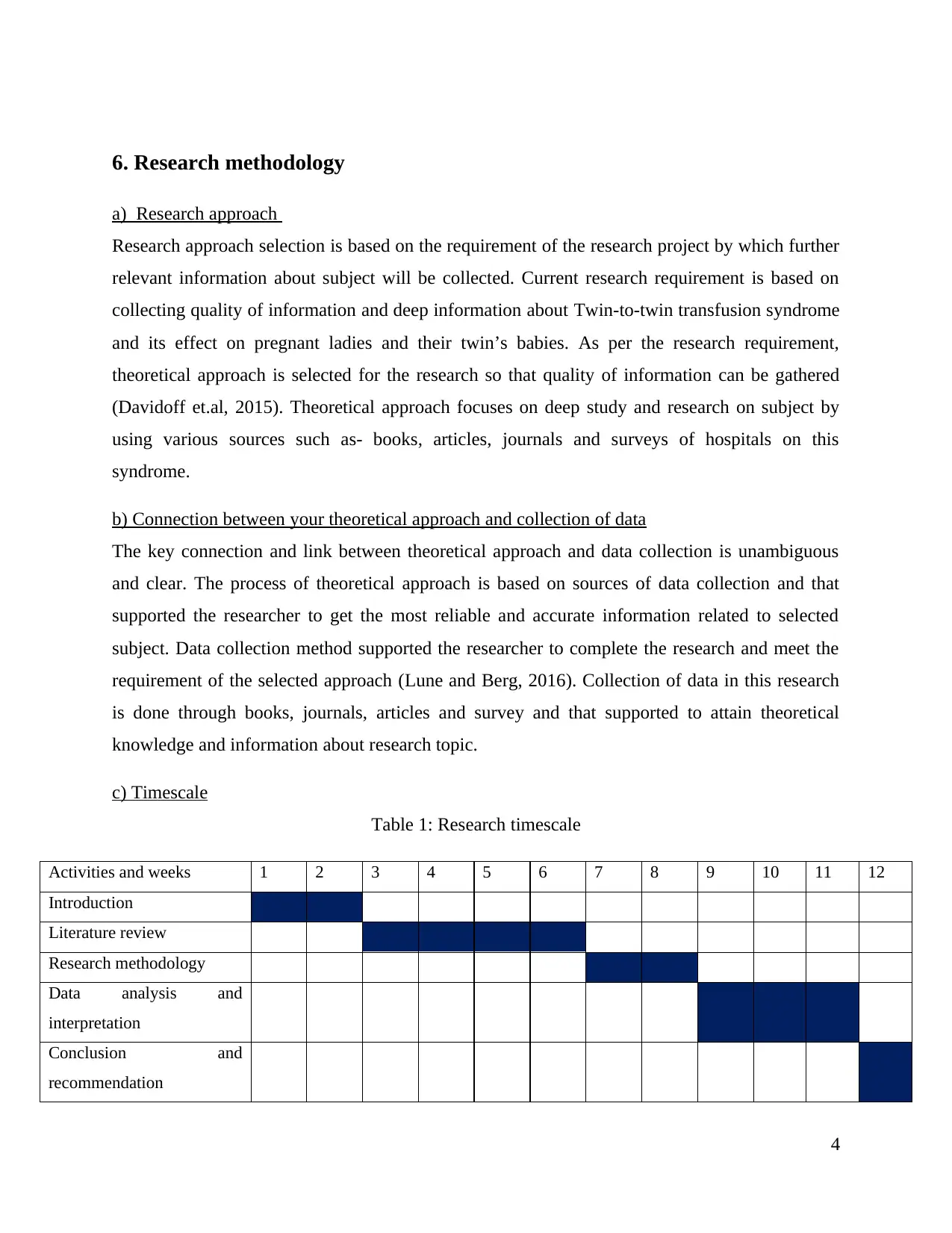
6. Research methodology
a) Research approach
Research approach selection is based on the requirement of the research project by which further
relevant information about subject will be collected. Current research requirement is based on
collecting quality of information and deep information about Twin-to-twin transfusion syndrome
and its effect on pregnant ladies and their twin’s babies. As per the research requirement,
theoretical approach is selected for the research so that quality of information can be gathered
(Davidoff et.al, 2015). Theoretical approach focuses on deep study and research on subject by
using various sources such as- books, articles, journals and surveys of hospitals on this
syndrome.
b) Connection between your theoretical approach and collection of data
The key connection and link between theoretical approach and data collection is unambiguous
and clear. The process of theoretical approach is based on sources of data collection and that
supported the researcher to get the most reliable and accurate information related to selected
subject. Data collection method supported the researcher to complete the research and meet the
requirement of the selected approach (Lune and Berg, 2016). Collection of data in this research
is done through books, journals, articles and survey and that supported to attain theoretical
knowledge and information about research topic.
c) Timescale
Table 1: Research timescale
Activities and weeks 1 2 3 4 5 6 7 8 9 10 11 12
Introduction
Literature review
Research methodology
Data analysis and
interpretation
Conclusion and
recommendation
4
a) Research approach
Research approach selection is based on the requirement of the research project by which further
relevant information about subject will be collected. Current research requirement is based on
collecting quality of information and deep information about Twin-to-twin transfusion syndrome
and its effect on pregnant ladies and their twin’s babies. As per the research requirement,
theoretical approach is selected for the research so that quality of information can be gathered
(Davidoff et.al, 2015). Theoretical approach focuses on deep study and research on subject by
using various sources such as- books, articles, journals and surveys of hospitals on this
syndrome.
b) Connection between your theoretical approach and collection of data
The key connection and link between theoretical approach and data collection is unambiguous
and clear. The process of theoretical approach is based on sources of data collection and that
supported the researcher to get the most reliable and accurate information related to selected
subject. Data collection method supported the researcher to complete the research and meet the
requirement of the selected approach (Lune and Berg, 2016). Collection of data in this research
is done through books, journals, articles and survey and that supported to attain theoretical
knowledge and information about research topic.
c) Timescale
Table 1: Research timescale
Activities and weeks 1 2 3 4 5 6 7 8 9 10 11 12
Introduction
Literature review
Research methodology
Data analysis and
interpretation
Conclusion and
recommendation
4
Paraphrase This Document
Need a fresh take? Get an instant paraphrase of this document with our AI Paraphraser
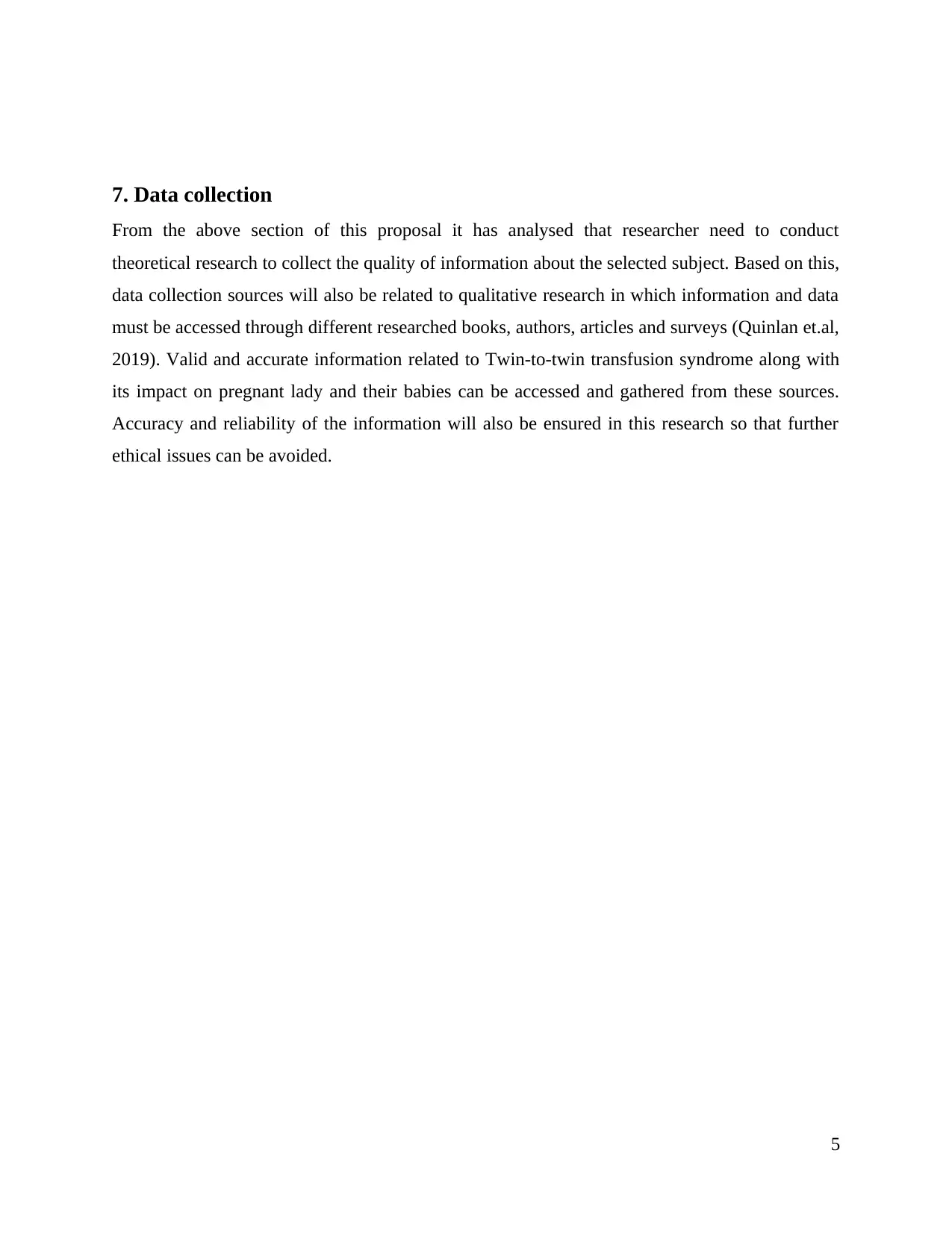
7. Data collection
From the above section of this proposal it has analysed that researcher need to conduct
theoretical research to collect the quality of information about the selected subject. Based on this,
data collection sources will also be related to qualitative research in which information and data
must be accessed through different researched books, authors, articles and surveys (Quinlan et.al,
2019). Valid and accurate information related to Twin-to-twin transfusion syndrome along with
its impact on pregnant lady and their babies can be accessed and gathered from these sources.
Accuracy and reliability of the information will also be ensured in this research so that further
ethical issues can be avoided.
5
From the above section of this proposal it has analysed that researcher need to conduct
theoretical research to collect the quality of information about the selected subject. Based on this,
data collection sources will also be related to qualitative research in which information and data
must be accessed through different researched books, authors, articles and surveys (Quinlan et.al,
2019). Valid and accurate information related to Twin-to-twin transfusion syndrome along with
its impact on pregnant lady and their babies can be accessed and gathered from these sources.
Accuracy and reliability of the information will also be ensured in this research so that further
ethical issues can be avoided.
5
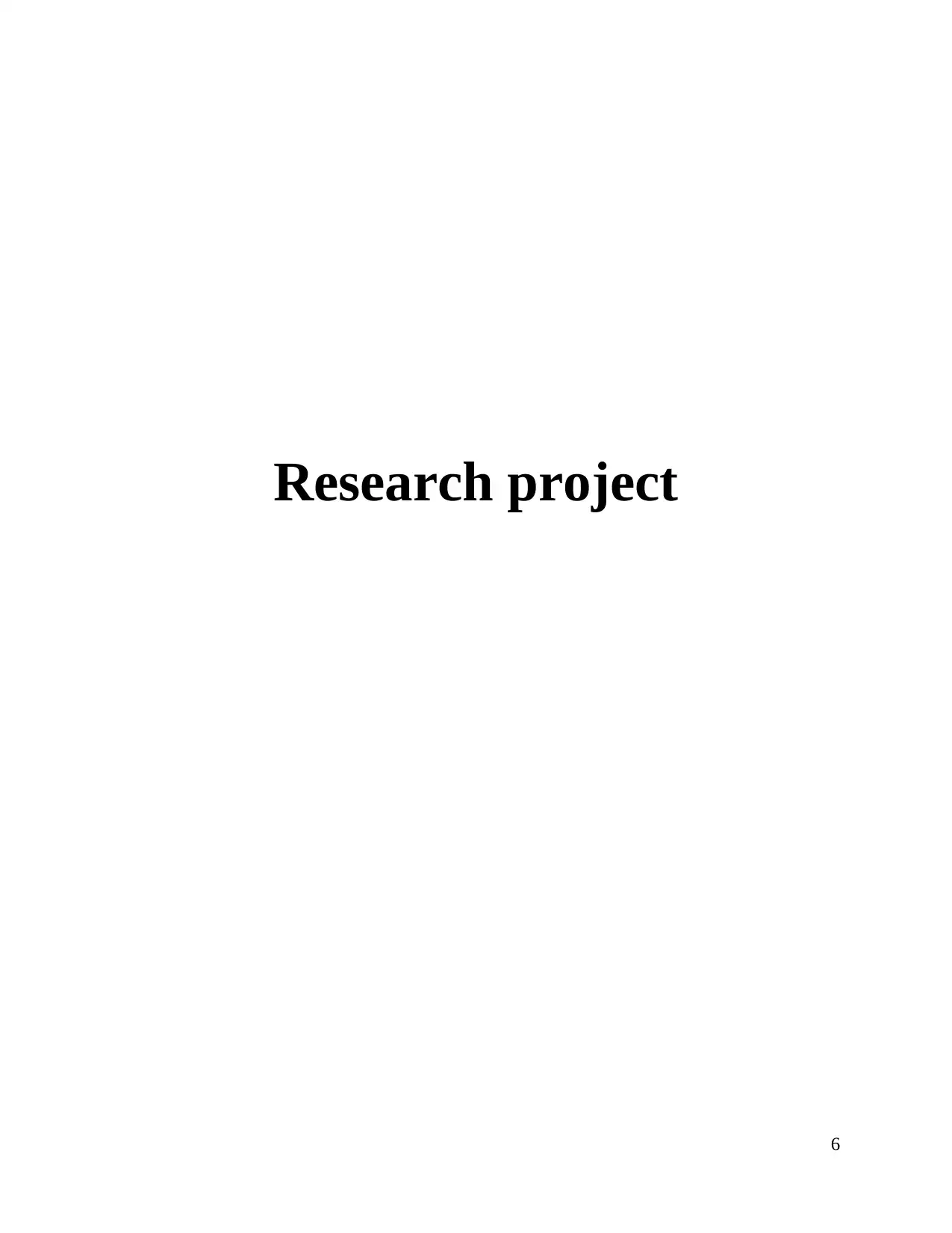
Research project
6
6
⊘ This is a preview!⊘
Do you want full access?
Subscribe today to unlock all pages.

Trusted by 1+ million students worldwide
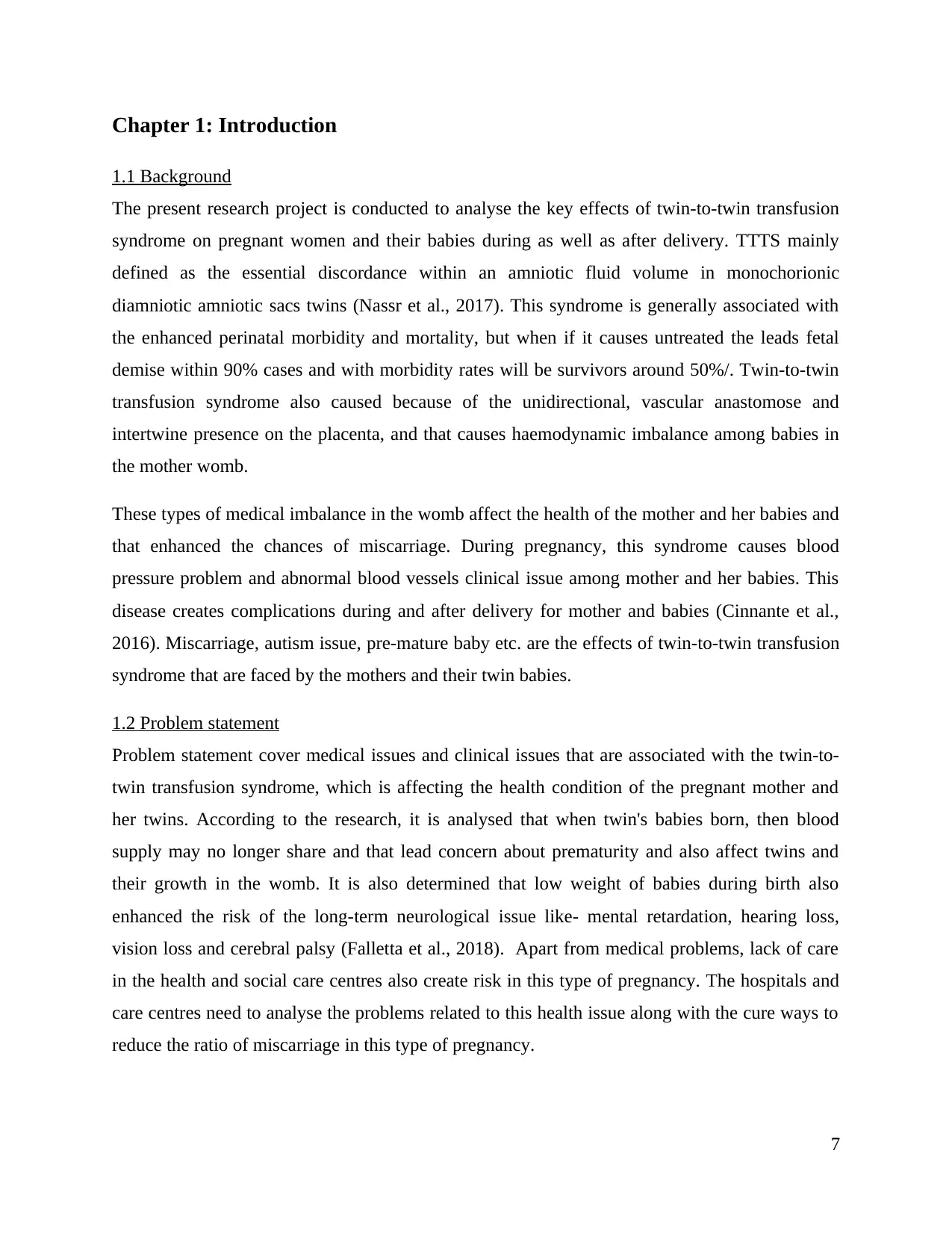
Chapter 1: Introduction
1.1 Background
The present research project is conducted to analyse the key effects of twin-to-twin transfusion
syndrome on pregnant women and their babies during as well as after delivery. TTTS mainly
defined as the essential discordance within an amniotic fluid volume in monochorionic
diamniotic amniotic sacs twins (Nassr et al., 2017). This syndrome is generally associated with
the enhanced perinatal morbidity and mortality, but when if it causes untreated the leads fetal
demise within 90% cases and with morbidity rates will be survivors around 50%/. Twin-to-twin
transfusion syndrome also caused because of the unidirectional, vascular anastomose and
intertwine presence on the placenta, and that causes haemodynamic imbalance among babies in
the mother womb.
These types of medical imbalance in the womb affect the health of the mother and her babies and
that enhanced the chances of miscarriage. During pregnancy, this syndrome causes blood
pressure problem and abnormal blood vessels clinical issue among mother and her babies. This
disease creates complications during and after delivery for mother and babies (Cinnante et al.,
2016). Miscarriage, autism issue, pre-mature baby etc. are the effects of twin-to-twin transfusion
syndrome that are faced by the mothers and their twin babies.
1.2 Problem statement
Problem statement cover medical issues and clinical issues that are associated with the twin-to-
twin transfusion syndrome, which is affecting the health condition of the pregnant mother and
her twins. According to the research, it is analysed that when twin's babies born, then blood
supply may no longer share and that lead concern about prematurity and also affect twins and
their growth in the womb. It is also determined that low weight of babies during birth also
enhanced the risk of the long-term neurological issue like- mental retardation, hearing loss,
vision loss and cerebral palsy (Falletta et al., 2018). Apart from medical problems, lack of care
in the health and social care centres also create risk in this type of pregnancy. The hospitals and
care centres need to analyse the problems related to this health issue along with the cure ways to
reduce the ratio of miscarriage in this type of pregnancy.
7
1.1 Background
The present research project is conducted to analyse the key effects of twin-to-twin transfusion
syndrome on pregnant women and their babies during as well as after delivery. TTTS mainly
defined as the essential discordance within an amniotic fluid volume in monochorionic
diamniotic amniotic sacs twins (Nassr et al., 2017). This syndrome is generally associated with
the enhanced perinatal morbidity and mortality, but when if it causes untreated the leads fetal
demise within 90% cases and with morbidity rates will be survivors around 50%/. Twin-to-twin
transfusion syndrome also caused because of the unidirectional, vascular anastomose and
intertwine presence on the placenta, and that causes haemodynamic imbalance among babies in
the mother womb.
These types of medical imbalance in the womb affect the health of the mother and her babies and
that enhanced the chances of miscarriage. During pregnancy, this syndrome causes blood
pressure problem and abnormal blood vessels clinical issue among mother and her babies. This
disease creates complications during and after delivery for mother and babies (Cinnante et al.,
2016). Miscarriage, autism issue, pre-mature baby etc. are the effects of twin-to-twin transfusion
syndrome that are faced by the mothers and their twin babies.
1.2 Problem statement
Problem statement cover medical issues and clinical issues that are associated with the twin-to-
twin transfusion syndrome, which is affecting the health condition of the pregnant mother and
her twins. According to the research, it is analysed that when twin's babies born, then blood
supply may no longer share and that lead concern about prematurity and also affect twins and
their growth in the womb. It is also determined that low weight of babies during birth also
enhanced the risk of the long-term neurological issue like- mental retardation, hearing loss,
vision loss and cerebral palsy (Falletta et al., 2018). Apart from medical problems, lack of care
in the health and social care centres also create risk in this type of pregnancy. The hospitals and
care centres need to analyse the problems related to this health issue along with the cure ways to
reduce the ratio of miscarriage in this type of pregnancy.
7
Paraphrase This Document
Need a fresh take? Get an instant paraphrase of this document with our AI Paraphraser
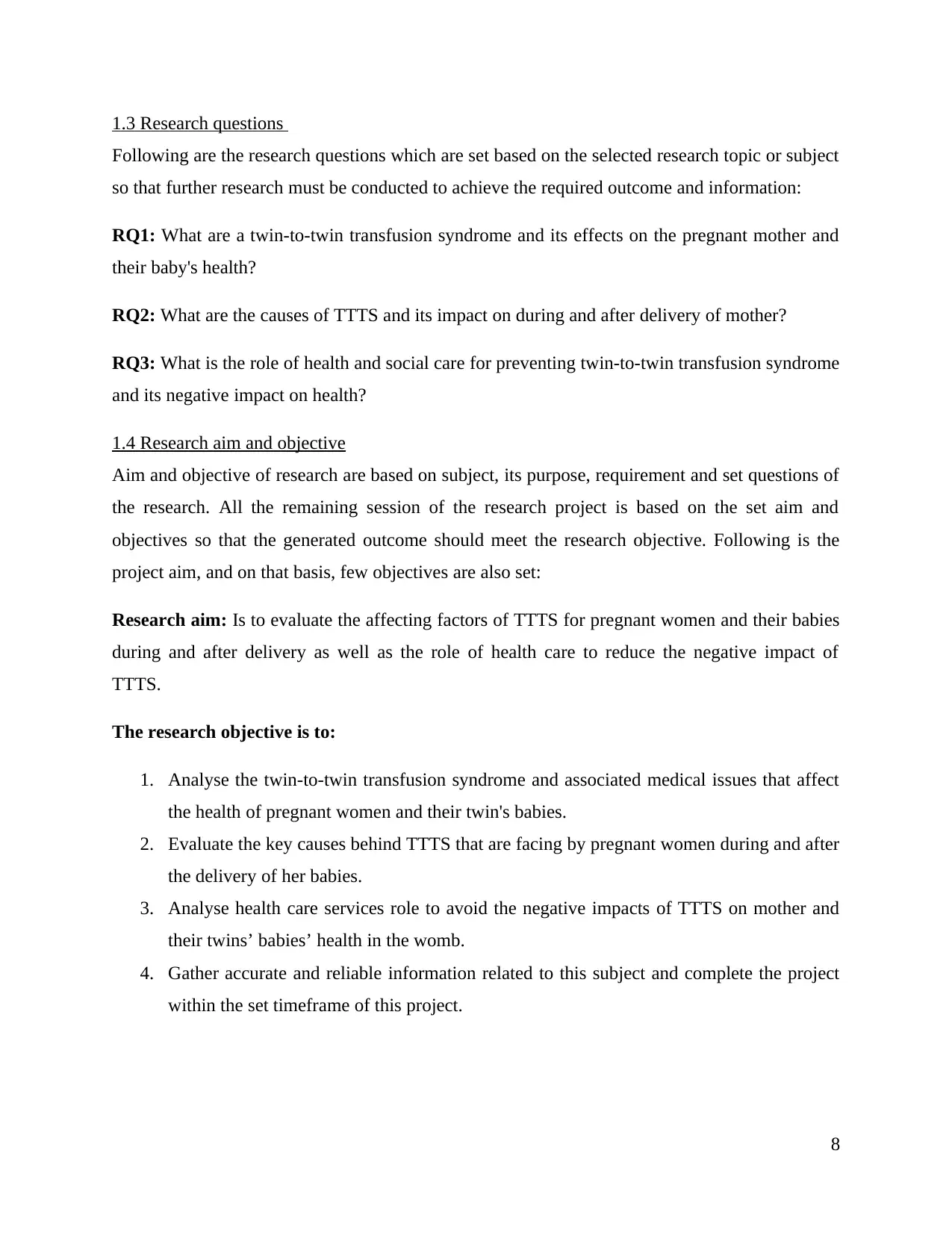
1.3 Research questions
Following are the research questions which are set based on the selected research topic or subject
so that further research must be conducted to achieve the required outcome and information:
RQ1: What are a twin-to-twin transfusion syndrome and its effects on the pregnant mother and
their baby's health?
RQ2: What are the causes of TTTS and its impact on during and after delivery of mother?
RQ3: What is the role of health and social care for preventing twin-to-twin transfusion syndrome
and its negative impact on health?
1.4 Research aim and objective
Aim and objective of research are based on subject, its purpose, requirement and set questions of
the research. All the remaining session of the research project is based on the set aim and
objectives so that the generated outcome should meet the research objective. Following is the
project aim, and on that basis, few objectives are also set:
Research aim: Is to evaluate the affecting factors of TTTS for pregnant women and their babies
during and after delivery as well as the role of health care to reduce the negative impact of
TTTS.
The research objective is to:
1. Analyse the twin-to-twin transfusion syndrome and associated medical issues that affect
the health of pregnant women and their twin's babies.
2. Evaluate the key causes behind TTTS that are facing by pregnant women during and after
the delivery of her babies.
3. Analyse health care services role to avoid the negative impacts of TTTS on mother and
their twins’ babies’ health in the womb.
4. Gather accurate and reliable information related to this subject and complete the project
within the set timeframe of this project.
8
Following are the research questions which are set based on the selected research topic or subject
so that further research must be conducted to achieve the required outcome and information:
RQ1: What are a twin-to-twin transfusion syndrome and its effects on the pregnant mother and
their baby's health?
RQ2: What are the causes of TTTS and its impact on during and after delivery of mother?
RQ3: What is the role of health and social care for preventing twin-to-twin transfusion syndrome
and its negative impact on health?
1.4 Research aim and objective
Aim and objective of research are based on subject, its purpose, requirement and set questions of
the research. All the remaining session of the research project is based on the set aim and
objectives so that the generated outcome should meet the research objective. Following is the
project aim, and on that basis, few objectives are also set:
Research aim: Is to evaluate the affecting factors of TTTS for pregnant women and their babies
during and after delivery as well as the role of health care to reduce the negative impact of
TTTS.
The research objective is to:
1. Analyse the twin-to-twin transfusion syndrome and associated medical issues that affect
the health of pregnant women and their twin's babies.
2. Evaluate the key causes behind TTTS that are facing by pregnant women during and after
the delivery of her babies.
3. Analyse health care services role to avoid the negative impacts of TTTS on mother and
their twins’ babies’ health in the womb.
4. Gather accurate and reliable information related to this subject and complete the project
within the set timeframe of this project.
8
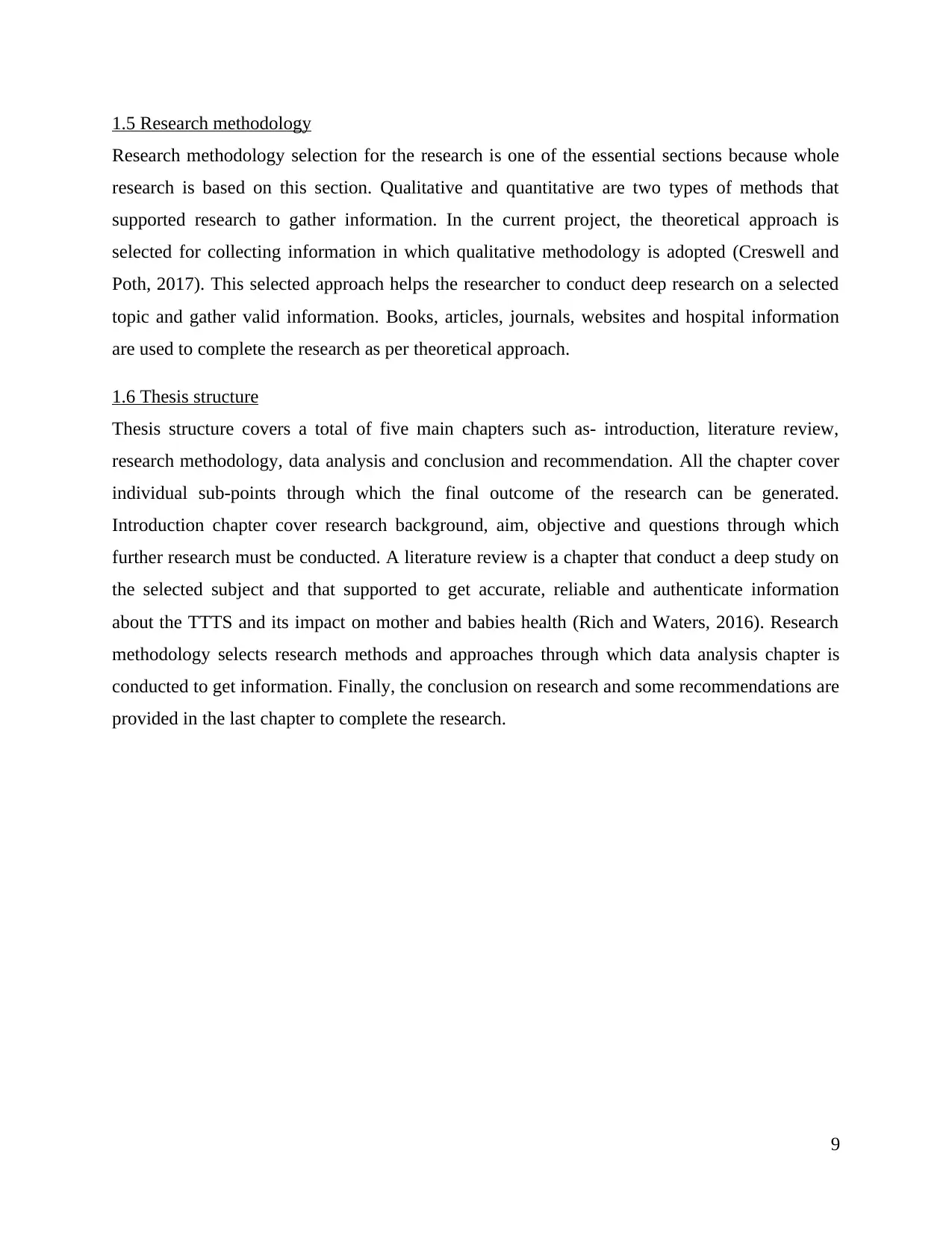
1.5 Research methodology
Research methodology selection for the research is one of the essential sections because whole
research is based on this section. Qualitative and quantitative are two types of methods that
supported research to gather information. In the current project, the theoretical approach is
selected for collecting information in which qualitative methodology is adopted (Creswell and
Poth, 2017). This selected approach helps the researcher to conduct deep research on a selected
topic and gather valid information. Books, articles, journals, websites and hospital information
are used to complete the research as per theoretical approach.
1.6 Thesis structure
Thesis structure covers a total of five main chapters such as- introduction, literature review,
research methodology, data analysis and conclusion and recommendation. All the chapter cover
individual sub-points through which the final outcome of the research can be generated.
Introduction chapter cover research background, aim, objective and questions through which
further research must be conducted. A literature review is a chapter that conduct a deep study on
the selected subject and that supported to get accurate, reliable and authenticate information
about the TTTS and its impact on mother and babies health (Rich and Waters, 2016). Research
methodology selects research methods and approaches through which data analysis chapter is
conducted to get information. Finally, the conclusion on research and some recommendations are
provided in the last chapter to complete the research.
9
Research methodology selection for the research is one of the essential sections because whole
research is based on this section. Qualitative and quantitative are two types of methods that
supported research to gather information. In the current project, the theoretical approach is
selected for collecting information in which qualitative methodology is adopted (Creswell and
Poth, 2017). This selected approach helps the researcher to conduct deep research on a selected
topic and gather valid information. Books, articles, journals, websites and hospital information
are used to complete the research as per theoretical approach.
1.6 Thesis structure
Thesis structure covers a total of five main chapters such as- introduction, literature review,
research methodology, data analysis and conclusion and recommendation. All the chapter cover
individual sub-points through which the final outcome of the research can be generated.
Introduction chapter cover research background, aim, objective and questions through which
further research must be conducted. A literature review is a chapter that conduct a deep study on
the selected subject and that supported to get accurate, reliable and authenticate information
about the TTTS and its impact on mother and babies health (Rich and Waters, 2016). Research
methodology selects research methods and approaches through which data analysis chapter is
conducted to get information. Finally, the conclusion on research and some recommendations are
provided in the last chapter to complete the research.
9
⊘ This is a preview!⊘
Do you want full access?
Subscribe today to unlock all pages.

Trusted by 1+ million students worldwide
1 out of 35
Related Documents
Your All-in-One AI-Powered Toolkit for Academic Success.
+13062052269
info@desklib.com
Available 24*7 on WhatsApp / Email
![[object Object]](/_next/static/media/star-bottom.7253800d.svg)
Unlock your academic potential
Copyright © 2020–2025 A2Z Services. All Rights Reserved. Developed and managed by ZUCOL.




